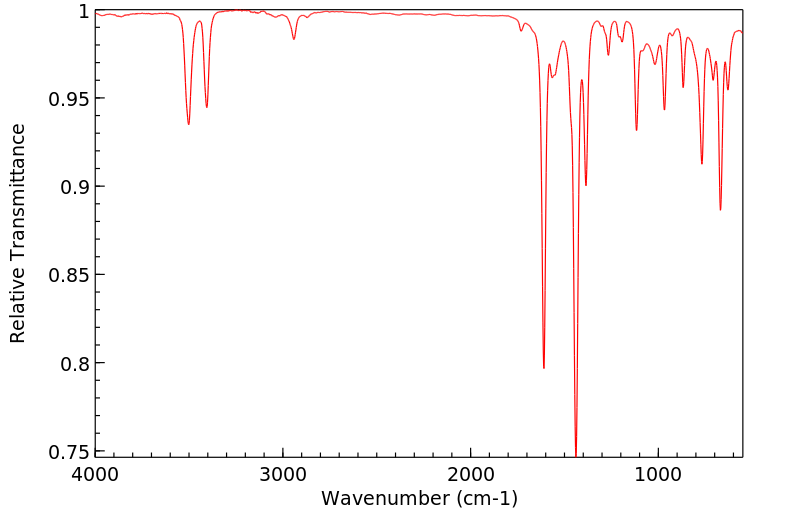3-甲基-2,4,6-三溴苯胺 | 71642-16-5
中文名称
3-甲基-2,4,6-三溴苯胺
中文别名
——
英文名称
3-methyl-2,4,6-tribromoaniline
英文别名
2,4,6-tribromo-3-methylaniline
CAS
71642-16-5
化学式
C7H6Br3N
mdl
MFCD00014768
分子量
343.843
InChiKey
KDZKZKWJNMBNAP-UHFFFAOYSA-N
BEILSTEIN
——
EINECS
——
-
物化性质
-
计算性质
-
ADMET
-
安全信息
-
SDS
-
制备方法与用途
-
上下游信息
-
文献信息
-
表征谱图
-
同类化合物
-
相关功能分类
-
相关结构分类
物化性质
-
熔点:101-102°C
-
沸点:314.1±37.0 °C(Predicted)
-
密度:2.196±0.06 g/cm3(Predicted)
-
稳定性/保质期:
强氧化剂、酸性氯化物和酸酐。
计算性质
-
辛醇/水分配系数(LogP):3.7
-
重原子数:11
-
可旋转键数:0
-
环数:1.0
-
sp3杂化的碳原子比例:0.14
-
拓扑面积:26
-
氢给体数:1
-
氢受体数:1
安全信息
-
安全说明:S22,S36/37
-
危险类别码:R20/21/22
-
海关编码:2921430090
-
储存条件:存放在密封容器内,并置于阴凉、干燥处,避免潮湿。
SDS
制备方法与用途
3-甲基-2,4,6-三溴苯胺是一种苯胺类衍生物,不仅可应用于医药合成,还可用作阻燃剂和抗氧化剂的原料。
上下游信息
-
下游产品
中文名称 英文名称 CAS号 化学式 分子量 —— 2-bromo-N-(2,4,6-tribromo-3-methylphenyl)acetamide 630120-36-4 C9H7Br4NO 464.777 2,4,6-三溴甲苯 2,4,6-tribromotoluene 6320-40-7 C7H5Br3 328.829 4-溴-N,N,3-三甲基苯胺 4-bromo-N,N,3-trimethylaniline 50638-50-1 C9H12BrN 214.105
反应信息
-
作为反应物:描述:3-甲基-2,4,6-三溴苯胺 在 potassium tetracyanocuprate 、 硫酸 、 水 、 氢溴酸 、 sodium nitrite 作用下, 生成 2,4,6-tribromo-3-methyl-benzoic acid参考文献:名称:13. 2-氯-3:5-二硝基-4-氯甲基-和2:4:6-三溴-3-溴甲基-苯甲酸,并试图解决它们摘要:DOI:10.1039/jr9350000068
-
作为产物:描述:3-甲基苯胺 在 benzyltrimethylammonium tribromide 、 calcium carbonate 作用下, 以 甲醇 、 二氯甲烷 为溶剂, 反应 0.5h, 以91%的产率得到3-甲基-2,4,6-三溴苯胺参考文献:名称:使用季铵多卤化物的卤化。六、苄基三甲基三溴化铵溴化芳香胺摘要:芳香胺与三溴化苄基三甲基铵在含有碳酸钙粉末的二氯甲烷-甲醇中在室温下反应 0.5 小时,以良好的收率得到溴取代的芳香胺。DOI:10.1246/bcsj.61.597
文献信息
-
Acetamides and benzamides that are useful in treating sexual dysfunction申请人:——公开号:US20040029887A1公开(公告)日:2004-02-12The present invention relates to the use of compounds of formula (I) 1 for the treatment of sexual dysfunction and to compositions containing compounds of formula (I) for the treatment of sexual dysfunction.本发明涉及使用式(I)的化合物治疗性功能障碍,以及含有式(I)化合物的组合物用于治疗性功能障碍。
-
Synthetic Clay Excels in <sup>90</sup>Sr Removal作者:Sridhar Komarneni、Tatsuya Kodama、William J. Paulus、C. CarlsonDOI:10.1557/jmr.2000.0182日期:2000.6ground water from Hanford site, and fundamental studies of 2Nasup +}yields}Srsup 2+} exchange equilibria revealed that a synthetic clay is extremely selective for sup 90}Sr with a high capacity for uptake. Comparative studies with existing Sr selective ion exchangers clearly revealed that the present synthetic clay exhibited the best performance for sup 90}Sr removal from actual ground water collected
-
Deuteriodediazoniation: A general method for the replacement of a diazonium group by deuterium作者:Frederick W. Wassmundt、William F. KiesmanDOI:10.1002/jlcr.2580360311日期:1995.3Aromatic amino groups are replaced with deuterium via a diazonium salt intermediate. Dimethylformamide-d7 is the deuterium donor in this mild replacement method that yields aromatic-d1 products in high isotopic purity. The presence of methyl groups lowers the isotopic purity of the products.
-
Supramolecular Assembly of Tris(4-carboxyphenyl)arenes: Relationship between Molecular Structure and Solid-State Catenation Motifs作者:Holden W. H. Lai、Ren A. Wiscons、Cassandra A. Zentner、Matthias Zeller、Jesse L. C. RowsellDOI:10.1021/acs.cgd.5b01416日期:2016.2.3The crystal structures of seven 1,3,5-tris(4-carboxyphenyl)arenes with functionalized central arene rings are reported. The formation of (6,3) hcb hexagonal sheets as a result of carboxylic acid dimer formation was observed in most of the crystal structures, with the exception of two compounds with functional groups capable of forming hydrogen bonds, namely, 2,4,6-tris(4-carboxyphenyl)-1,3-diaminobenzene and 2,4,6-tris(4-carboxyphenyl)-3-methylaniline. These structures were found to incorporate THF solvent molecules in their hydrogen-bonding motif, giving rise to distorted pseudohexagonal arrays. Functional groups on the central ring were found to influence stacking distances, stacking offsets, inclination angles, degree of catenation, and dimensions of solvent-occupied channels. To better understand and appreciate these complicated crystal structures, they were categorized into four distinct stacking/catenation families: simple stacking, single-layer offset catenation, double-layer offset catenation, and rotated-layer catenation. The unique structure of the unfunctionalized parent compound 1,3,5-tris(4-carboxyphenyl)benzene is rationalized in light of the structural behavior of its derivatives.报告了七种具有官能化中央炔环的 1,3,5-三(4-羧基苯基)炔的晶体结构。在大多数晶体结构中都观察到了由于羧酸二聚体的形成而形成的 (6,3) hcb 六边形薄片,但有两种化合物除外,它们的官能团能够形成氢键,这两种化合物是 2,4,6- 三(4-羧基苯基)-1,3-二氨基苯和 2,4,6- 三(4-羧基苯基)-3-甲基苯胺。研究发现,这些结构的氢键基团中含有四氢呋喃溶剂分子,从而形成了扭曲的假六边形阵列。研究发现,中心环上的官能团会影响堆叠距离、堆叠偏移、倾斜角度、斤化程度以及溶剂占据通道的尺寸。为了更好地理解和认识这些复杂的晶体结构,我们将它们分为四个不同的堆叠/卡氏化系列:简单堆叠、单层偏移卡氏化、双层偏移卡氏化和旋转层卡氏化。根据 1,3,5-三(4-羧基苯基)苯衍生物的结构行为,合理解释了未官能化母体化合物 1,3,5-三(4-羧基苯基)苯的独特结构。
-
Azofarbstoffe sowie deren Herstellung und Verwendung zum Färben von Synthesefasern申请人:BAYER AG公开号:EP0033443A1公开(公告)日:1981-08-12Azofarbstoffe der Formel (I) worin R1 für F, Cl, Br, J, CF3, Cycloalkyl, -NO2, -CN, -SO2CF3, -CO-Alkyl, -C02-Alkyl, -NH-Alkyl, -N-(Alkyl)2, -NHCO-Alkyl, NHSO2-Alkyl, R2 für H, Cl, Br oder CH3, X, für H, Cl oder Br, V für gegebenenfalls substituiertes C1-C6-Alkyl oder für Aralkyl stehen, eignen sich ausgezeichnet zum Färben von Polyesterfasern. Die erhaltenen Färbungen zeichnen sich bei guten Licht-, Naß-und Sublimierechtheiten durch besonders klare Farbtöne aus.
表征谱图
-
氢谱1HNMR
-
质谱MS
-
碳谱13CNMR
-
红外IR
-
拉曼Raman
-
峰位数据
-
峰位匹配
-
表征信息
同类化合物
(βS)-β-氨基-4-(4-羟基苯氧基)-3,5-二碘苯甲丙醇
(S,S)-邻甲苯基-DIPAMP
(S)-(-)-7'-〔4(S)-(苄基)恶唑-2-基]-7-二(3,5-二-叔丁基苯基)膦基-2,2',3,3'-四氢-1,1-螺二氢茚
(S)-盐酸沙丁胺醇
(S)-3-(叔丁基)-4-(2,6-二甲氧基苯基)-2,3-二氢苯并[d][1,3]氧磷杂环戊二烯
(S)-2,2'-双[双(3,5-三氟甲基苯基)膦基]-4,4',6,6'-四甲氧基联苯
(S)-1-[3,5-双(三氟甲基)苯基]-3-[1-(二甲基氨基)-3-甲基丁烷-2-基]硫脲
(R)富马酸托特罗定
(R)-(-)-盐酸尼古地平
(R)-(-)-4,12-双(二苯基膦基)[2.2]对环芳烷(1,5环辛二烯)铑(I)四氟硼酸盐
(R)-(+)-7-双(3,5-二叔丁基苯基)膦基7''-[((6-甲基吡啶-2-基甲基)氨基]-2,2'',3,3''-四氢-1,1''-螺双茚满
(R)-(+)-7-双(3,5-二叔丁基苯基)膦基7''-[(4-叔丁基吡啶-2-基甲基)氨基]-2,2'',3,3''-四氢-1,1''-螺双茚满
(R)-(+)-7-双(3,5-二叔丁基苯基)膦基7''-[(3-甲基吡啶-2-基甲基)氨基]-2,2'',3,3''-四氢-1,1''-螺双茚满
(R)-(+)-4,7-双(3,5-二-叔丁基苯基)膦基-7“-[(吡啶-2-基甲基)氨基]-2,2”,3,3'-四氢1,1'-螺二茚满
(R)-3-(叔丁基)-4-(2,6-二苯氧基苯基)-2,3-二氢苯并[d][1,3]氧杂磷杂环戊烯
(R)-2-[((二苯基膦基)甲基]吡咯烷
(R)-1-[3,5-双(三氟甲基)苯基]-3-[1-(二甲基氨基)-3-甲基丁烷-2-基]硫脲
(N-(4-甲氧基苯基)-N-甲基-3-(1-哌啶基)丙-2-烯酰胺)
(5-溴-2-羟基苯基)-4-氯苯甲酮
(5-溴-2-氯苯基)(4-羟基苯基)甲酮
(5-氧代-3-苯基-2,5-二氢-1,2,3,4-oxatriazol-3-鎓)
(4S,5R)-4-甲基-5-苯基-1,2,3-氧代噻唑烷-2,2-二氧化物-3-羧酸叔丁酯
(4S,4''S)-2,2''-亚环戊基双[4,5-二氢-4-(苯甲基)恶唑]
(4-溴苯基)-[2-氟-4-[6-[甲基(丙-2-烯基)氨基]己氧基]苯基]甲酮
(4-丁氧基苯甲基)三苯基溴化磷
(3aR,8aR)-(-)-4,4,8,8-四(3,5-二甲基苯基)四氢-2,2-二甲基-6-苯基-1,3-二氧戊环[4,5-e]二恶唑磷
(3aR,6aS)-5-氧代六氢环戊基[c]吡咯-2(1H)-羧酸酯
(2Z)-3-[[(4-氯苯基)氨基]-2-氰基丙烯酸乙酯
(2S,3S,5S)-5-(叔丁氧基甲酰氨基)-2-(N-5-噻唑基-甲氧羰基)氨基-1,6-二苯基-3-羟基己烷
(2S,2''S,3S,3''S)-3,3''-二叔丁基-4,4''-双(2,6-二甲氧基苯基)-2,2'',3,3''-四氢-2,2''-联苯并[d][1,3]氧杂磷杂戊环
(2S)-(-)-2-{[[[[3,5-双(氟代甲基)苯基]氨基]硫代甲基]氨基}-N-(二苯基甲基)-N,3,3-三甲基丁酰胺
(2S)-2-[[[[[((1S,2S)-2-氨基环己基]氨基]硫代甲基]氨基]-N-(二苯甲基)-N,3,3-三甲基丁酰胺
(2S)-2-[[[[[[((1R,2R)-2-氨基环己基]氨基]硫代甲基]氨基]-N-(二苯甲基)-N,3,3-三甲基丁酰胺
(2-硝基苯基)磷酸三酰胺
(2,6-二氯苯基)乙酰氯
(2,3-二甲氧基-5-甲基苯基)硼酸
(1S,2S,3S,5S)-5-叠氮基-3-(苯基甲氧基)-2-[(苯基甲氧基)甲基]环戊醇
(1S,2S,3R,5R)-2-(苄氧基)甲基-6-氧杂双环[3.1.0]己-3-醇
(1-(4-氟苯基)环丙基)甲胺盐酸盐
(1-(3-溴苯基)环丁基)甲胺盐酸盐
(1-(2-氯苯基)环丁基)甲胺盐酸盐
(1-(2-氟苯基)环丙基)甲胺盐酸盐
(1-(2,6-二氟苯基)环丙基)甲胺盐酸盐
(-)-去甲基西布曲明
龙蒿油
龙胆酸钠
龙胆酸叔丁酯
龙胆酸
龙胆紫-d6
龙胆紫







